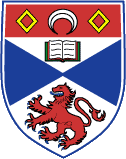Team:St Andrews
From 2010.igem.org
| Line 1: | Line 1: | ||
| + | __NOTOC__ | ||
[[Image:St_Andrews_logo.png|100px|left]] | [[Image:St_Andrews_logo.png|100px|left]] | ||
__NOTOC__ | __NOTOC__ | ||
Revision as of 17:25, 15 July 2010
| Home | Team | Official Team Profile | Project | Parts Submitted to the Registry | Modeling | Notebook | Safety |
|---|
|
Our multidisciplinary team is the first to hail from St Andrews University, consisting of biology students: Dave and Sarah, medical students: Rachael and Fatimeh, physicists: Alasdair and Patrick, computer scientist Jaunty, chemist Jim and biochemist Lukas. We are overseen by advisors Olivia, Anne, Wim, Chris and Michael. The ProblemThe St Andrews iGEM team plan is to do something useful with quorum sensing – the method by which bacteria make decisions in a cell density dependent manner. They do this by secreting autoinducer molecules, which diffuse back into the cells and regulate their own biosynthesis. Certain concentrations of autoinducer represent to a bacterium an amount of fellow-bacteria in the environment and the response is activation or deactivation of a set of genes. We are interested in the quorum sensing system of Vibrio cholerae, the bacterium understood to be responsible for the deadly diarrhoeal disease, cholera. Cholera is extremely rare in the developed world, but in areas with poor sanitation it affects people who drink unsafe water. Young children are the most at risk, and left untreated death can occur by dehydration. According to the WHO, cholera kills between 100,000 and 120,000 people every year. Efforts have been made towards an effective cholera vaccine suitable for young children, but they have not yet been successful. It is now suggested that synthetic probiotic bacteria could be a safe and economical way to confer resistance to cholera. Quorum Sensing in V. CholeraeMost cholera cells are killed off by stomach acid, but those that remain alive attach to the gut wall and multiply. At this low cell density, autoinducer concentration is low, and virulence factors are expressed. Once high cell density is reached, enough toxin is present to cause severe diarrhoea. At this point, the autoinducer concentration is high, and virulence factors are repressed. The now avirulent V. Cholerae detach from the gut wall and are flushed out of the body to infect a new host. Our idea is to synthesise E. coli bacteria that will use this ingenious mechanism to communicate with V. cholerae. Our engineered E. coli will harmlessly colonise the gut, and in large numbers secrete the cholera autoinducer, CAI-1. This will cause an immediate high autoinducer concentration to be detected by incoming V. cholerae cells which then become avirulent and harmlessly pass out of the body. Our PlanThe wet work will focus on two challenges. The first being to add new functionality to the signalling parts present in the registry by re-engineering the existing LuxR quorum sensing system to create a bistable switch. This will allow us to infer a signalling molecule concentration required to deactivate the system much lower than the concentration required to activate it. We will characterise this system by using a fluorescent protein reporter and measuring fluorescence at different cell densities. The second challenge will be adding the cholera autoinducer synthase gene CqsA to E. coli so that CAI-1 is secreted. The eventual aim is that the bistable switching system will be used to control CqsA expression, so that the ability to compete with other bacteria in the human gut is not compromised by this metabolic burden. The computational side of the team are focusing on generating ordinary differential equations to model quorum sensing in V. cholerae and on modelling more complex problems such as bistability and multiple quorum loops working in tandem of our parts. |
 "
"
